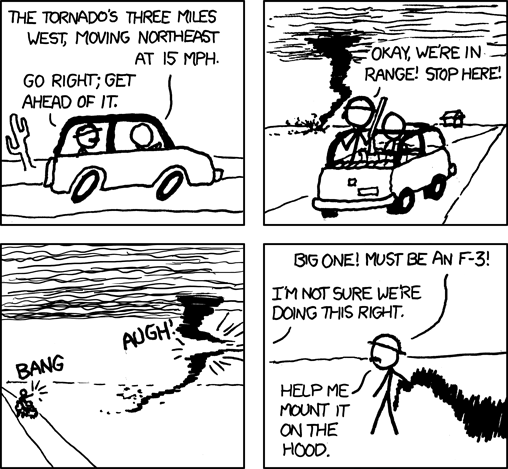Difference between revisions of "640: Tornado Hunter"
m (clean up) |
|||
| Line 9: | Line 9: | ||
==Explanation== | ==Explanation== | ||
| − | This is a play on the occupations/hobbies "{{w|tornado chaser}}" | + | This is a play on the occupations/hobbies "{{w|tornado chaser}}" -- someone who, instead of evacuating the area like normal people, actually goes in to get a closer look at the tornado -- and "{{w|big game hunter}}", who often kill for trophies. Tornado chasers are typically, but not always, {{w|meteorologists}}. The "F-3" is a reference to the {{w|Fujita scale}} used to classify tornado intensity. It goes from 1 to 5, with 5 being the highest, with an updated {{w|Enhanced Fujita scale}}, as mentioned in the title text, being used in the US since 2007. |
==Transcript== | ==Transcript== | ||
Revision as of 03:34, 24 July 2013
Explanation
This is a play on the occupations/hobbies "tornado chaser" -- someone who, instead of evacuating the area like normal people, actually goes in to get a closer look at the tornado -- and "big game hunter", who often kill for trophies. Tornado chasers are typically, but not always, meteorologists. The "F-3" is a reference to the Fujita scale used to classify tornado intensity. It goes from 1 to 5, with 5 being the highest, with an updated Enhanced Fujita scale, as mentioned in the title text, being used in the US since 2007.
Transcript
- [Two people are in a car, which is driving past a cactus. The passenger has a pith helmet and a mustache.]
- Cueball: The tornado's three miles west, moving northeast at 15 mph.
- Passenger: Go right; get ahead of it.
- [A tornado is visible. The passenger pulls out a gun, and stands up in the car.]
- Passenger: Okay, we're in range! Stop here!
- [The passenger fires a gun at the tornado.]
- BANG
- Tornado: AUGH!
- Passenger: Big one! Must be an F-3!
- Cueball: I'm not sure we're doing this right.
- Passenger: Help me mount it on the hood.
- [The passenger is holding the tornado by its tail.]
Discussion
I'm not sure if Randall knew this, but the "EF" in the Enhanced Fujita ratings is still pronounced the same as the letter F.--68.97.21.122 02:51, 8 July 2013 (UTC)
I'm Australian, but I have been given to believe tornados don't normally occur in areas where cacti grow? 108.162.250.223 (talk) (please sign your comments with ~~~~)
Tornadoes are not as common in places such as Arizona and New Mexico (examples of states where cacti grow) as they are further East, but they do occur. "In the Southwestern United States, New Mexico reported 485 tornadoes during the 1950 to 2006 period (NCDC figures), California reported 355, Arizona reported 209, and Nevada reported 75.[15] New Mexico borders the notoriously tornado prone states of Texas and Oklahoma, hence the noticeably higher figures. Most of the tornadoes here happen in the very eastern part of the state. New Mexico's region and the desert landscape of the state help prevent the amount of twisters that happen in Oklahoma and Texas. [15] Arizona and New Mexico experience regular summer thunderstorms during their monsoon season. These are sometimes tornadic but rarely produce violent tornadoes." (https://en.wikipedia.org/wiki/Tornadoes_in_the_United_States#West_and_Southwest) -- Npsych (talk) (please sign your comments with ~~~~)
Added title text explanation. How it was that there wasn't one, yet no one marked it incomplete, I'll never know. 162.158.255.90 17:56, 27 December 2015 (UTC)

